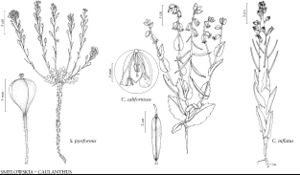Caulanthus inflatus
Proc. Amer. Acad. Arts 17: 364. 1882.
Annuals; glabrous or sparsely (or densely) pilose basally. Stems erect, unbranched or branched distally, (hollow, strongly inflated, fusiform, to 4 cm diam. at widest point), 1.5–9.7 dm. Basal leaves rosulate; petiole 0.5–5 cm; blade obovate to oblanceolate, 1–13 cm × 5–60 mm, margins entire or dentate-sinuate. Cauline leaves (distalmost) sessile; blade ovate to lanceolate, 1–20 cm × 5–70 mm (base amplexicaul), margins entire. Racemes (densely flowered), without a terminal cluster of sterile flowers. Fruiting pedicels ascending to divaricate, 3–12 mm, sparsely to densely pilose, or glabrous. Flowers: sepals erect, (dark purple at least apically, whitish basally), narrowly ovate to lanceolate or oblong-lanceolate, 5.5–14 × 2–3 mm (unequal, adaxial one slightly smaller or narrower, keeled); petals purple, 9–14 mm, blade 3–4 × 1.5–2 mm, crisped, claw oblanceolate to oblong, 6–10 × 1.5–3 mm; filaments in 3 unequal pairs, (median pairs connate), abaxial pair 4–8 mm, lateral pair 3–5 mm, adaxial pair 7–10 mm; anthers narrowly oblong, equal, 2–4 mm. Fruits erect to ascending, terete, 3.5–12.7 cm × 2–3 mm; valves each with prominent midvein; ovules 58–82 per ovary; style obsolete or, rarely, to 0.4 mm; stigma strongly 2-lobed (lobes opposite valves). Seeds 1.5–3 × 0.7–1.7 mm. 2n = 28.
Phenology: Flowering Feb–Jun.
Habitat: Desert plains, dry hillsides
Elevation: 150-1500 m
Discussion
Caulanthus inflatus is found in central and southern California.
Selected References
None.
Lower Taxa
"elongated" is not a number."thick" is not a number."dm" is not declared as a valid unit of measurement for this property.

